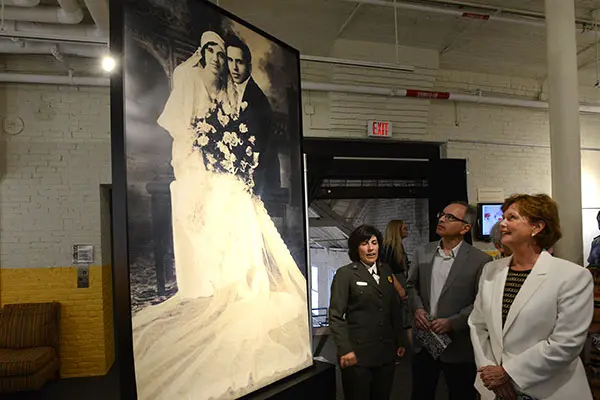Unearthed Artifacts Tell Stories of Labor and Love

08/18/2015
By Julia Gavin
Led by the Holy Ghost Marching Band, more than 150 people paraded into the Boott Cotton Mills Museum on a summer night to celebrate the opening of an exhibit highlighting the Portuguese community’s history and influence in Lowell
“The Lure of the Spindle: The Portuguese in Early 20th Century Lowell” showcases the lives of immigrants at work and in the community and explores their devotion to faith, family and neighborhood. The exhibit was inspired by historic records discovered last year in the attic of Lowell City Hall.
Coincidentally, the artifacts came to light shortly before Prof. Frank Sousa arrived at the university to direct the Saab-Pedroso Center for Portuguese Culture and Research. The exhibit took shape over the last year and a half.
“It was serendipity,” says Sousa, speaking of the discovery of letters, passports, photographs and visas, which detail the lives of thousands of Portuguese laborers who arrived in Massachusetts more than 100 years ago. The immigrants, many of whom originally traveled to Massachusetts to work in the whaling industry, worked alongside many other groups in the Lowell mills.
The exhibit, which is presented in partnership with the university’s Center for Lowell History (CFLH) and Lowell National Historical Park, included historical and contemporary collections of photographs, maps, city records and cultural and religious artifacts.
“This exhibit tells a story. It tells our story, of how so many of us come from different backgrounds and different places,” said Chancellor Jacquie Moloney. “It tells the story of our dreams, our hopes and aspirations and of the dedication of the immigrant community of this city.”
The opening drew people from around the region who came to pore over photos and letters, searching for a mention of their relatives. Barbara Wilson made the trip back to Lowell from Greenland, NH with family members to see her parents’ wedding photo on display. The couple, John and Elsie Falante, raised their family on Chapel Street in the predominantly Portuguese Back Central neighborhood and walked to church at St. Anthony’s every week.
Some things haven’t changed in the neighborhood.
Steve Mendonca, a volunteer with the same parish who grew up in Lowell after his parents immigrated to the city in the 1960s, said his mother still makes the same walk to St. Anthony’s every day.
“I’m very impressed with the rich history that our ancestors have,” said Mendonca, who was excited to learn more about the earlier wave of immigrants who “laid the foundation” for his parents’ generation.
Sousa hopes the exhibit and the center’s work will raise awareness of Portuguese contributions to the region. Established in 2013, the center promotes the languages, literatures and cultures of the Portuguese-speaking world, comprised of more than 230 million people, while advancing the presence and visibility of the Portuguese culture and community throughout the Merrimack Valley.
“The Portuguese are an under-documented group at the state and federal levels and this is a way to enhance the understanding of the local community and their contributions,” said Sousa. The event also brought many community members to the museum for the first time. “This is part of what the university and our partners can do. We can make that connection,” said Sousa.
Hidden Documents Create Public History
Before graduating in May, history alum Mark Gozzo scanned and researched many of the unearthed documents for his History, Writing and Community class during his internship with the CFLH. He used genealogical records and other sources to write a research paper about the Portuguese community in Lowell over time, which informed pieces of the exhibit.
“It was a good experience for me in using history skills and getting a concrete result,” said Gozzo, who would like to continue working in public history, making the past relevant and useful to the general public. “It feels good to be part of something that so many people obviously feel strongly about.”
The exhibit is funded in part by Mass Humanities, which receives support from the Massachusetts Cultural Council and is an affiliate of the National Endowment for the Humanities. Other exhibit partners include the Tsongas Industrial History Center, the Lowell Historical Society and the International Institute of New England, with additional documentation from St. Anthony of Padua Parish and the American Folklife Center at the Library of Congress.
It is on display until Dec. 1 and is free to the public. For more about the Portuguese-American experience in Lowell, visit the CFLH's Portuguese Immigrant Archives.
